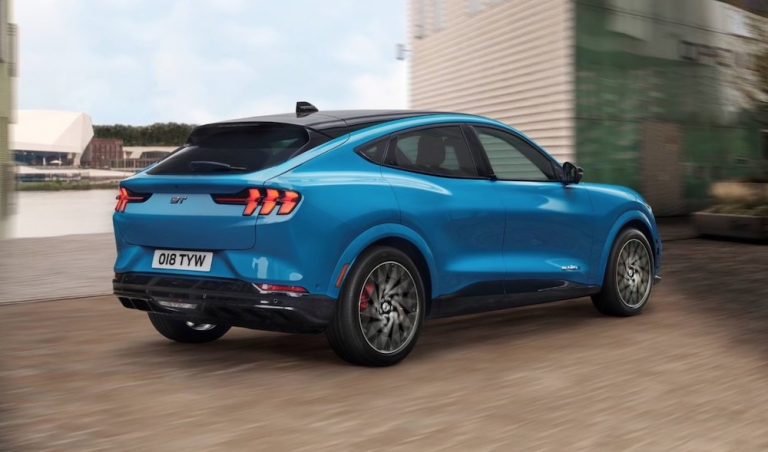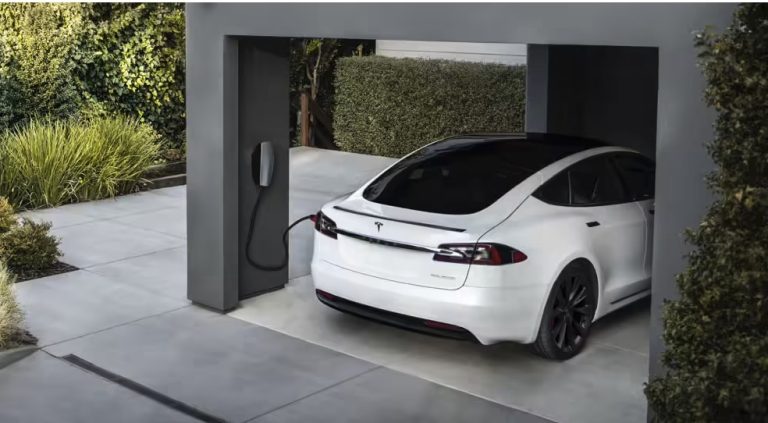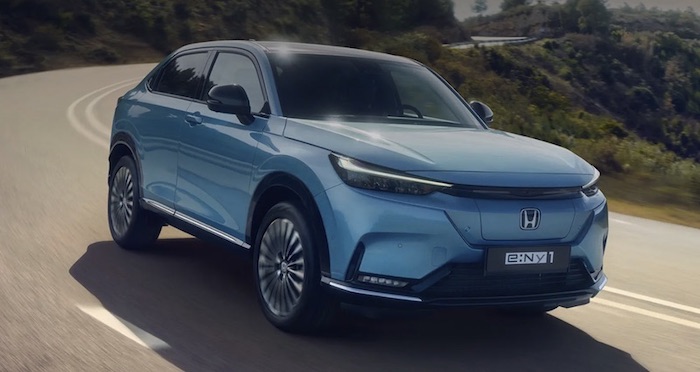Electric Cars: The Basics
For those of you new to zero-emission electric driving, we recommend a read of the following articles:
Sign up to the e-zoomed Electric Living newsletter
The All-Electric Ford Explorer SUV
Ford is the second-largest automotive manufacturer in the United States, and in the top 10 globally. The company is largely owned by institutional investors (60%). However, the Executive Chairman of the Ford board is William Clay Ford Jr., the great-grandson of Henry Ford. The company has operations globally, to include: United States, Canada, Mexico, China, India, the United Kingdom, Germany, Turkey, Brazil, Argentina, Australia, and South Africa. As of 2023, the company sold over 4.4 million cars worldwide.
The Ford electric vehicle (EV) portfolio includes both, battery-electric vehicle (BEV) and plug-in hybrid electric vehicle (PHEV) models:
- All-electric Ford Capri
- All-electric Ford Mustang Mach-E
- All-electric Ford Explorer
- Ford Kuga Plug-in Hybrid
The all-electric Ford Explorer (C-Segment) mid-sized crossover is the second battery-electric vehicle (BEV) from the manufacturer, and was revealed in March 2023. The first BEV from Ford is the all-electric Ford Mustang Mach-e. The Ford Explorer five-door internal combustion engine (ICE) SUV was launched in 1991 as a replacement of the Ford Bronco SUV. The Ford Explorer is currently in its sixth-generation, and in 2020 became the best-selling SUV of all time in the USA. The Ford Explorer EV shares its name and inspiration from the conventional internal combustion engine (ICE) variant.
However, the Explorer electric has been developed on a completely different platform to the combustion variants. The mid-sized Ford Explorer EV uses the Volkswagen Group’s MEB platform. Audi, Cupra and Skoda also use the same modular platform. The Volkswagen ID.Family also uses the MEB platform, to include the all-electric Volkswagen ID.4, a rival option to the Explorer electric.
The Explorer EV is manufactured in Cologne, Germany (at the new Ford Cologne EV Centre) . Production commenced in June 2024. The Volkswagen-Ford partnership has tried to combine the best of German engineering, with the best of American SUV design! We believe a good approach, given the proven track record of the Volkswagen MEB platform. Of course, winning customer loyalty is another matter, given the already fierce competition in the all-electric SUV segment, to include the best-selling Tesla Model Y SUV.
Though the all-electric Ford Explorer has three EV battery size options, currently the only options available are the 82 kWh and 84 kWh. The smaller 55 kWh EV battery option is expected to be available from late 2024. We continue to encourage automotive manufacturers to offer battery-electric vehicles (BEVs) i.e. all-electric vehicles, with multiple EV battery size options. In reality, for a number of individuals and families, the day-to-day driving needs are limited to shorter trips (school runs, grocery store, gym etc), therefore a smaller EV battery like the 55 kWh option is more than adequate. Do also keep in mind, smaller the onboard EV battery, the lower the price of the EV!
The claimed WLTP range for the rear-wheel drive (RWD) 82 kWh variant is 602 km, with an electric energy consumption between 13.9 – 18.4 kWh/100 km. Adjusting for real-world driving conditions, expect an e-range up to 515 km on a full charge. For the all-wheel drive (AWD) 84 kWh variant, the manufacturer claims a WLTP range up to 528 km, with electric energy consumption between 16.7 – 21.5 kWh/100 km. Expect a real-world e-range closer to 450 km. Either way, an excellent range for most day-to-day driving needs. Ford is yet to specify the WLTP certified range for the entry-level rear-wheel drive (RWD) 55 kWh EV battery option, but the target range is 385 km.
The EV offers a maximum DC charging capability up to 185 kW DC for the top spec AWD 84 kWh model (10%-80%: 26 mins). The RWD 82 kWh EV offers up to 135 kW DC (10%-80%: 28 mins). The entry-level RWD 55 kWh offers up to 125 kW DC charging. It is worth noting that competitors like Genesis offer a faster DC charging capability (up to 350 kW DC). In any case, most EVs are charged at home. AC charging, single-phase (or three-phase) and usually overnight. We encourage the use of solar and battery storage for charging an electric car. e-zoomed offers fantastic bundle offers on residential PV solar and home energy storage systems.
Despite the price tag, the heat pump is not standard. For those new to electric driving, an onboard heat pump helps improve the efficiency of the electric vehicle (EV) i.e. increase the available zero-tailpipe emission electric range. Other ways to increase electric range is to use the onboard regenerative braking modes.
The EV offer a reasonable level of technology and equipment for both trim levels (Select/ Premium). Some of these include: full digital cluster screen 5.3″, 14.6″ SYNC Move Touchscreen, inductive wireless phone charging, wireless compatibility with Android Auto and Apple CarPlay, 12 ultrasonic sensors, 5 cameras, 3 radars, intelligent adaptive cruise control with stop & go, lane keeping aid & lane departure warning, traffic sign recognition with navigation with wrong way alert, cross traffic alert (CTA) w/ active braking and exit warning, dual-zone electronic automatic temperature control (DEATC), rear view camera, pre-conditioning (battery and cabin), and more. The BEV has a Five-Star NCAP Rating.
In terms of practicality, the five-seat, five-door family e-SUV does not have a frunk. A frunk is a storage space/ compartment/ trunk in the front of a vehicle, rather than the rear. In the case of pure electric cars, given that these electric vehicles do not have an onboard internal combustion engine (ICE), there is space for a frunk below the bonnet. Given the high roof, the Explorer offers good headroom, even for taller adults seated in the rear. Legroom is also more than adequate.
The interior is to a good standard of quality, and Ford has incorporated some clever interior features, like the 17-litre ‘MegaConsole’ that can hold a 15-inch laptop or multiple 1.5-litre drink bottles. The available boot size is 470 L, though smaller than rivals, it is adequate. The panoramic roof is only standard on the higher trim! The Explorer is 1.63m tall and 4.46m long. By way of comparison, the all-electric Polestar 4 SUV is 1.53m tall and 4.84m long. The Polestar 4 offers a 526 L boot! In terms of exterior styling, we do believe the Ford Explorer EV is attractive, further enhanced by the new layout of the Ford Explorer badge!
The electric SUV is available as both, a rear-wheel drive (RWD) and all-wheel drive (AWD) variant. The 82 kWh RWD variant can achieve 0-100 km/h in 6.4 seconds (maximum power: 286 PS/ torque: 545 Nm). While the 82 kWh AWD variant can achieve 0-100 km/h in 5.3 seconds (maximum power: 340 PS/ torque: 679 Nm). The top speed of the electric vehicle (EV) is 180 km/h.
Bottom-line, electric driving is good for the environment and the wallet. It can also be exhilarating!
| PROS | CONS |
|---|---|
| Available in multiple EV battery size options and practical real-world electric range | Heat pump not standard |
| Good level of equipment and technology onboard | No frunk |
| Spacious and good quality interior | DC charging not as fast as some competitors |
The All-Electric Ford Explorer SUV (credit: Ford)
| At A Glance | |
|---|---|
| EV Type: | Battery-Electric Vehicle (BEV) |
| Vehicle Type: | SUV |
| Engine: | Electric |
| Available In Ireland: | Yes |
| € Variants (2 Options) |
|---|
| Ford Explorer Electric Select (from € 43,591) |
| Ford Explorer Electric Premium (from € 48,005) |
| EV Battery & Emissions | |
|---|---|
| EV Battery Type: | Lithium-ion |
| EV Battery Capacity: | Available in three battery sizes: 55 kWh/ 82 kWh/ 84 kWh |
| Charging: | 135-185 kW DC Rapid Charging (10%-80%: 26-28 minutes). Onboard AC charger: N/A kW AC (0%-100%: 9-13 hrs) |
| Charge Port: | Type 2 |
| EV Cable Type: | Type 2 |
| Tailpipe Emissions: | 0g (CO2/km) |
| Warranty: | 8 years or 160,000 km |
| Average Cost Of Residential Charging | |
|---|---|
| Battery net capacity: 16.7 kWh | € 4.00 |
| Battery net capacity: 30.0 kWh | € 7.19 |
| Battery net capacity: 39.2 kWh | € 9.39 |
| Battery net capacity: 45.0 kWh | € 10.78 |
| Battery net capacity: 50.0 kWh | € 11.98 |
| Battery net capacity: 64.0 kWh | € 15.34 |
| Battery net capacity: 71.0 kWh | € 17.01 |
| Battery net capacity: 77.0 kWh | € 18.45 |
| Battery net capacity: 90.0 kWh | € 21.57 |
| Battery net capacity: 100.0 kWh | € 23.97 |
- Note 1: The average cost of residential electricity in Ireland varies depending on the region, supplier and type of energy used. An average for Ireland is 23.97 cents/kWh.
- Note 2: Not all EV manufactures make available the data on net EV battery capacity, and in a number of instances the EV battery capacity advertised, does not state if it is gross or net capacity. In general, usable EV battery capacity is between 85% to 95% of the gross available capacity.
| Charging Times (Overview) | |
|---|---|
| Slow charging AC (3 kW – 3.6 kW): | 6 – 12 hours (dependent on size of EV battery & SOC) |
| Fast charging AC (7 kW – 22 kW): | 3 – 8 hours (dependent on size of EV battery & SoC) |
| Rapid charging AC (43 kW): | 0-80%: 20 mins to 60 mins (dependent on size of EV battery & SoC) |
| Rapid charging DC (50 kW+): | 0-80%: 20 mins to 60 mins (dependent on size of EV battery & SoC) |
| Ultra rapid charging DC (150 kW+): | 0-80% : 20 mins to 40 mins (dependent on size of EV battery & SoC) |
| Tesla Supercharger (120 kW – 250 kW): | 0-80%: up to 25 mins (dependent on size of EV battery & SoC) |
- Note 1: SoC: state of charge
| Dimensions | |
|---|---|
| Height (mm): | 1630 |
| Width (mm): | 1871 |
| Length (mm): | 4468 |
| Wheelbase (mm): | 2767 |
| Turning Circle (m): | 10.8 |
| Boot Space (L): | 470 |
| Frunk (L): | N/A |
| RWD 55 kWh | |
|---|---|
| EV Battery Capacity: | 55 kWh |
| Pure Electric Range (WLTP): | 385 km (target range) |
| Electric Energy Consumption (kWh/100 km): | 15.5 |
| Charging: | 125 kW DC charging (10%-80%: 28 mins). Onboard charger: N/A kW AC (0%-100%: N/A hrs) |
| Top Speed: | 180 km/h |
| 0-100 km/h: | TBC |
| Drive: | Rear-wheel drive (RWD) |
| Electric Motor (kW): | 125 |
| Max Power (PS): | 170 |
| Torque (Nm): | 310 |
| Transmission: | Automatic |
| Seats: | 5 |
| Doors: | 5 |
| Kerb Weight (kg): | TBC |
| Towing Capacity (Braked/Unbraked)/ (kg): | TBC |
| Colours: | 6 |
| NCAP Safety Rating: | Five-Star |
| RWD 82 kWh | |
|---|---|
| EV Battery Capacity: | 82 kWh |
| Pure Electric Range (WLTP): | 602 km |
| Electric Energy Consumption (kWh/100 km): | 13.9 – 18.4 |
| Charging: | 135 kW DC charging (10%-80%: 28 mins). Onboard charger: N/A kW AC (0%-100%: N/A hrs) |
| Top Speed: | 180 km/h |
| 0-100 km/h: | 6.4 seconds |
| Drive: | Rear-wheel drive (RWD) |
| Electric Motor (kW): | 210 |
| Max Power (PS): | 286 |
| Torque (Nm): | 545 |
| Transmission: | Automatic |
| Seats: | 5 |
| Doors: | 5 |
| Kerb Weight (kg): | 2,090 |
| Towing Capacity (Braked/Unbraked)/ (kg): | 1,000 (12% gradient)/ 750 |
| Colours: | 6 |
| NCAP Safety Rating: | Five-Star |
| AWD 84 kWh | |
|---|---|
| EV Battery Capacity: | 84 kWh |
| Pure Electric Range (WLTP): | 528 km |
| Electric Energy Consumption (kWh/100 km): | 16.7 – 21.5 |
| Charging: | 185 kW DC charging (10%-80%: 26 mins). Onboard charger: N/A kW AC (0%-100%: N/A hrs) |
| Top Speed: | 180 km/h |
| 0-100 km/h: | 5.3 seconds |
| Drive: | All-wheel drive (AWD) |
| Electric Motor (kW): | 250 |
| Max Power (PS): | 340 |
| Torque (Nm): | 679 |
| Transmission: | Automatic |
| Seats: | 5 |
| Doors: | 5 |
| Kerb Weight (kg): | 2,179 |
| Towing Capacity (Braked/Unbraked)/ (kg): | 1,200 (12% gradient)/ 750 |
| Colours: | 6 |
| NCAP Safety Rating: | Five-Star |
Air Quality: An Overview
If there is one common theme that unites many of us, it is the concern over worsening air quality in our villages, towns and cities. This concern is not unique to Ireland, but a narrative that is now firmly centre stage globally. The detrimental health consequences of higher pollution, in particular, on the vulnerable, like children and the elderly is significant, and well documented.
According to the WHO (World Health Organisation), the PM2.5 concentration in Ireland is currently 1.6 times higher than the WHO annual air quality guideline value. WHO has described air pollution as the ‘single biggest environmental health risk’, leading to an increase in the risk of stroke, heart disease, lung cancer and respiratory diseases.
Electric vehicles and in particular, zero-tailpipe emission EVs, also known as battery-electric vehicles (BEVs), help improve local air quality i.e. a pure electric car does not have a tailpipe/ exhaust, hence, zero-tailpipe emissions! Without an iota of doubt, all types of EVs, to include, plug-in hybrid electric vehicles (PHEVs), are better for improving air quality, compared to conventional petrol and diesel vehicles. We encourage all drivers in Ireland to migrate to lower emission electric driving.
| Type Of Pollutants |
|---|
| Particulate matter (PM or PM 2.5) |
| Ammonia (NH3) |
| Nitrogen Oxide (NOx) |
| Sulphur Dioxide (SO2) |
| Non-methane volatile organic compounds (NMVOCS) |
| Primary Sources Of Pollutants |
|---|
| Road transportation |
| Industrial processes |
| Farming and agricultural processes |
| Waste industry |
| Energy generation |
| Domestic burning |
| Other forms of transportation, such as aviation, shipping and railroads |
While e-zoomed uses reasonable efforts to provide accurate and up-to-date information, some of the information provided is gathered from third parties and has not been independently verified by e-zoomed. While the information from the third party sources is believed to be reliable, no warranty, express or implied, is made by e-zoomed regarding the accuracy, adequacy, completeness, legality, reliability or usefulness of any information. This disclaimer applies to both isolated and aggregate uses of this information.






























